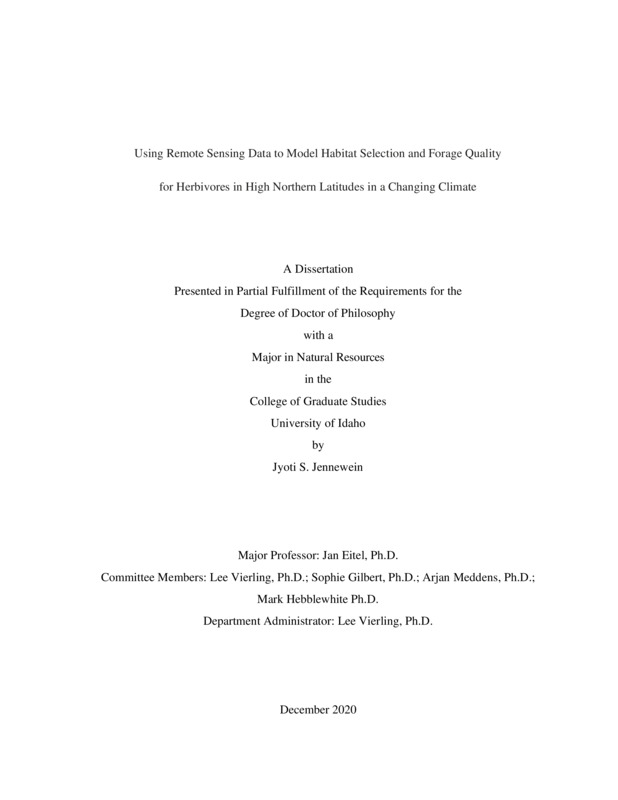Using Remote Sensing Data to Model Habitat Selection and Forage Quality for Herbivores in High Northern Latitudes in a Changing Climate
Jennewein, Jyoti. (2020-12). Using Remote Sensing Data to Model Habitat Selection and Forage Quality for Herbivores in High Northern Latitudes in a Changing Climate. Theses and Dissertations Collection, University of Idaho Library Digital Collections. https://www.lib.uidaho.edu/digital/etd/items/jennewein_idaho_0089e_11965.html
- Title:
- Using Remote Sensing Data to Model Habitat Selection and Forage Quality for Herbivores in High Northern Latitudes in a Changing Climate
- Author:
- Jennewein, Jyoti
- ORCID:
- 0000-0002-9650-6537
- Date:
- 2020-12
- Keywords:
- Alaska climate change forage quality habitat selection hyperspectral structure from motion
- Program:
- Natural Resources
- Subject Category:
- Remote sensing; Environmental science; Natural resource management
- Abstract:
-
Landscapes located in high northern latitudes (≥ 60°N) are changing at a rate two to three times the global mean. Research is needed to assess the current state of northern latitude regions to best identify the impacts of climate change, which can inform the advancement of policies and management strategies. In response to warming induced landscape changes, management agencies are identifying practical “adaptive strategies” that may mitigate the negative effects of climate change. One such strategy in wildlife management is to evaluate and enhance monitoring programs, and to consider incorporating new tools to augment monitoring efforts.
Geospatial tools are one set of technologies that may enhance evaluation and monitoring for wildlife management. These tools enable spatial data to be collected, analyzed, and visualized in ways that assist in planning and management activities. Two common geospatial tools used in wildlife management are (1) mobile Global Positioning Systems (GPS) that can be housed in collars worn by a variety of species, and (2) remote sensing, which collects noncontact information regarding the physical and biological characteristics from a given target using reflected or emitted radiation.
The second chapter of this dissertation incorporates remotely sensed products in conjunction with GPS-telemetry from four Alaska moose populations to assess how habitat selection changes in response to increased temperatures. Both male and female moose in all populations increasingly, and nonlinearly, selected for denser canopy cover as ambient temperature increased during summer, where initial increases in the conditional probability of selection were initially sharper then leveled out as canopy density increased above ~50%. However, the magnitude of selection response varied by population and sex. In two of the three populations containing both sexes, females demonstrated a stronger selection response for denser canopy at higher temperatures than males. We also observed a stronger selection response in the most southerly and northerly populations compared to populations in the west and central Alaska.
The third and fourth chapters of this dissertation explore the development of remote sensing approaches to characterize, monitor, and map forage quality in high latitude regions of Alaska. I used hyperspectral data in conjunction with plant structural metrics derived from digital photographs and unmanned aerial vehicle structure from motion photogrammetry. My results suggested that spectral vegetation indices calculated from hyperspectral remote sensing are an appropriate method for estimating important forage quality metrics such as dietary fibers (Chapter 3) – hemicellulose, cellulose, neutral detergent fiber, acid detergent fiber, acid detergent fiber, and silica – as well as integrated forage metrics (Chapter 4) – digestible protein and dry matter digestibility. My results also indicated that incorporating shrub structure is an important, and often unconsidered, aspect of remotely sensed forage quality metrics.
- Description:
- doctoral, Ph.D., Natural Resources -- University of Idaho - College of Graduate Studies, 2020-12
- Major Professor:
- Eitel, Jan U.H.
- Committee:
- Vierling, Lee A; Gilbert, Sophie; Meddens, Arjan; Hebblewhite, Mark
- Defense Date:
- 2020-12
- Identifier:
- Jennewein_idaho_0089E_11965
- Type:
- Text
- Format Original:
- Format:
- application/pdf
- Rights:
- In Copyright - Educational Use Permitted. For more information, please contact University of Idaho Library Special Collections and Archives Department at libspec@uidaho.edu.
- Standardized Rights:
- http://rightsstatements.org/vocab/InC-EDU/1.0/

